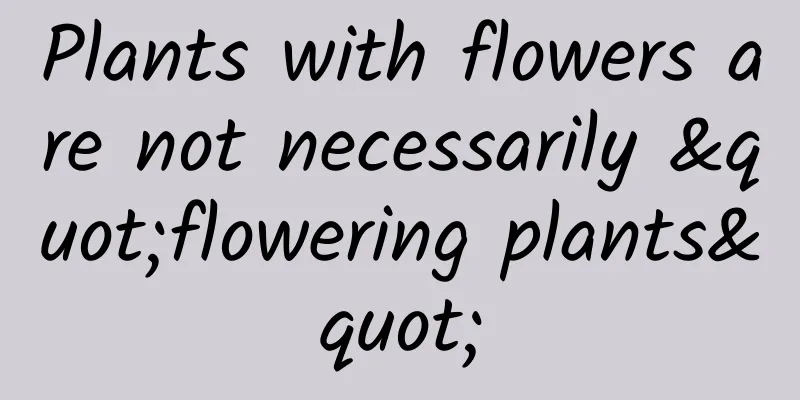Plants with flowers are not necessarily "flowering plants"

|
Produced by: Science Popularization China Author: Life Pulse Team Producer: China Science Expo If you visit a botanical garden, you will definitely be attracted by the various colorful flowers there. Every spring, the large and small flowers blooming in the fields, hillsides, courtyards and roadsides accompanied by the warm spring breeze always make people feel the breath of spring. As a creature living in the new generation, humans are lucky. We can not only enjoy the food provided by various plants, but also enjoy the beauty brought to us by flowers. Therefore, humans have been particularly interested in flowers since ancient times. (Photo source: veer photo gallery) Flowers are always a theme for artists to depict or carve; in the works of poets and writers, there are always endless words to praise flowers. For botanists, flowers are also the focus of their research, and they are even regarded as a term in taxonomy - the name "flowering plant" has long been used as a synonym for seed plants, including gymnosperms and angiosperms. The "flowers" in "flowering plants" refer to the presence of "perianthus" or "spore leaf group", but in fact, ferns already have spore leaf groups, while gymnosperms do not have true perianths. Therefore, strictly speaking, "flowering plants" cannot really represent seed plants, so this name has gradually been discontinued. However, it is precisely because the flowers of angiosperms have true perianths that flowers have become their most important organ that distinguishes them from other plants. Therefore, when people mention flowers, they often think of this large group classified by botanists as angiosperms. Moreover, it is precisely because angiosperms have various advanced characteristics, including advanced flowers, that they have become the most dominant group in the plant kingdom on Earth from the beginning of the Cenozoic Era to the present. It can be said that angiosperms are the best among flowering plants and also the best in the entire plant kingdom. So, where is the "outstanding" of angiosperms? Like gymnosperms, angiosperms reproduce sexually with seeds. The difference between the two is that the megasporangium (ovule) of gymnosperms is naked, and the seeds that develop into it are not covered on the outside and are also naked; while the ovule of angiosperms is wrapped in the ovary, and the ovule develops into seeds and the ovary develops into fruits. The seeds are wrapped in the fruit and are no longer exposed. This difference is the most important difference between the two major types of plants, and therefore it is the origin of the names of gymnosperms and angiosperms. And this difference itself has reflected the more advanced characteristics of angiosperms than gymnosperms-protected seeds are more conducive to propagation and development into a new generation of plants. In addition, angiosperms have a series of other advanced features. As reproductive organs, the conidia of gymnosperms look very much like their flowers, but compared with the flowers of angiosperms, they are much more primitive. They either have only pistils or only stamens, and are generally just a spherical body composed of fruit scales (such as pine cones). In the Permian period, some gymnosperms also had perianths, but these perianths were much simpler than those of angiosperms. The flowers of angiosperms originated from the conidia of gymnosperms, but they are much more advanced than the conidia. A typical angiosperm flower consists of calyx, corolla (the two are collectively called perianth), stamens and pistils. The corolla is composed of petals, which are formed by the degeneration of small sporophylls. The cells of the petals contain a variety of anthocyanins and aromatic oils, so the flowers are brightly colored, colorful and fragrant. There are also nectaries at the base of the petals, which can secrete sweet and fragrant juice, which adds to the fragrance of the flowers. These bright colors and aromatic smells of flowers can attract various insects to visit; while insects search, pick or absorb nutrients from flowers, they also pollinate plants. From then on, in addition to pollination by wind, there is an additional effective way for sexual reproduction in the plant kingdom. This way actually reflects the establishment of a mutually beneficial relationship between plants and insects. This mutual benefit allows plants and insects to evolve together, which greatly increases the biodiversity in the ecosystem on the one hand, and opens up a broader path for the evolution and development of angiosperms and insects on the other hand. In addition, angiosperms have shown progress in many processes of genetics and development, as well as in structures such as stems and leaves. Plants are vital to life on Earth. They are most widely used in natural life and have the closest relationship with humans. Therefore, exploring the secrets hidden in plants can help us more deeply understand and recognize our planet. |
>>: Can cactus protect against computer radiation? Do you have a cactus on your desk?
Recommend
Git's good partner: SourceTree & BeyondCompare
As a coder, you must be familiar with source code...
Where did the lost atmosphere of Mars go? The latest discovery is that it may be "hidden" on Mars
Produced by: Science Popularization China Author:...
2021 Yixiantian Chip System (Fourth Issue)
: : : : : : : : : : : : : : : : : : : : : : : : : ...
Build a super fast computer for deep learning for less than $1,000: Continue the exploration of deep learning and cheap hardware!
[[192381]] Yes, you can run TensorFlow on a $39 R...
Export suspended! What exactly is natural sand?
Recently, according to the official website of th...
How much does it cost to attract investment for the Chongzuo Lighting Mini Program? What is the Chongzuo Lighting Mini Program investment quotation?
How much is the investment price in Chongzuo Ligh...
Use this "retention rate model" to calculate how far your product is from making a million a day?
Almost all operational work is carried out around...
Creative materials for short videos, high-scoring video and picture materials! !
Can you email me the video special effects materi...
20 years after the Chang'e project was launched, a picture of China's lunar exploration project
In the past 20 years, China's lunar explorati...
4 elements to effectively increase user growth!
In the circle, whenever the word "growth&quo...
Introduction to Hua Qiangu: How to use formal optimization operations to make the website ranked?
With the adjustment of Baidu algorithm, many coll...
Still worried about AirPods being lost? A brooch can help
Apple's first truly wireless earphone product ...
How to quickly find eight golden rules for APP operation and promotion shortcuts! !
The eight golden rules introduced in this article...
How to start Baidu information flow advertising from 0 to 1?
Baidu information flow was developed after Baidu ...
Whether or not to do agency operation, you will understand it immediately after reading these points!
However, judging from the current market conditio...









